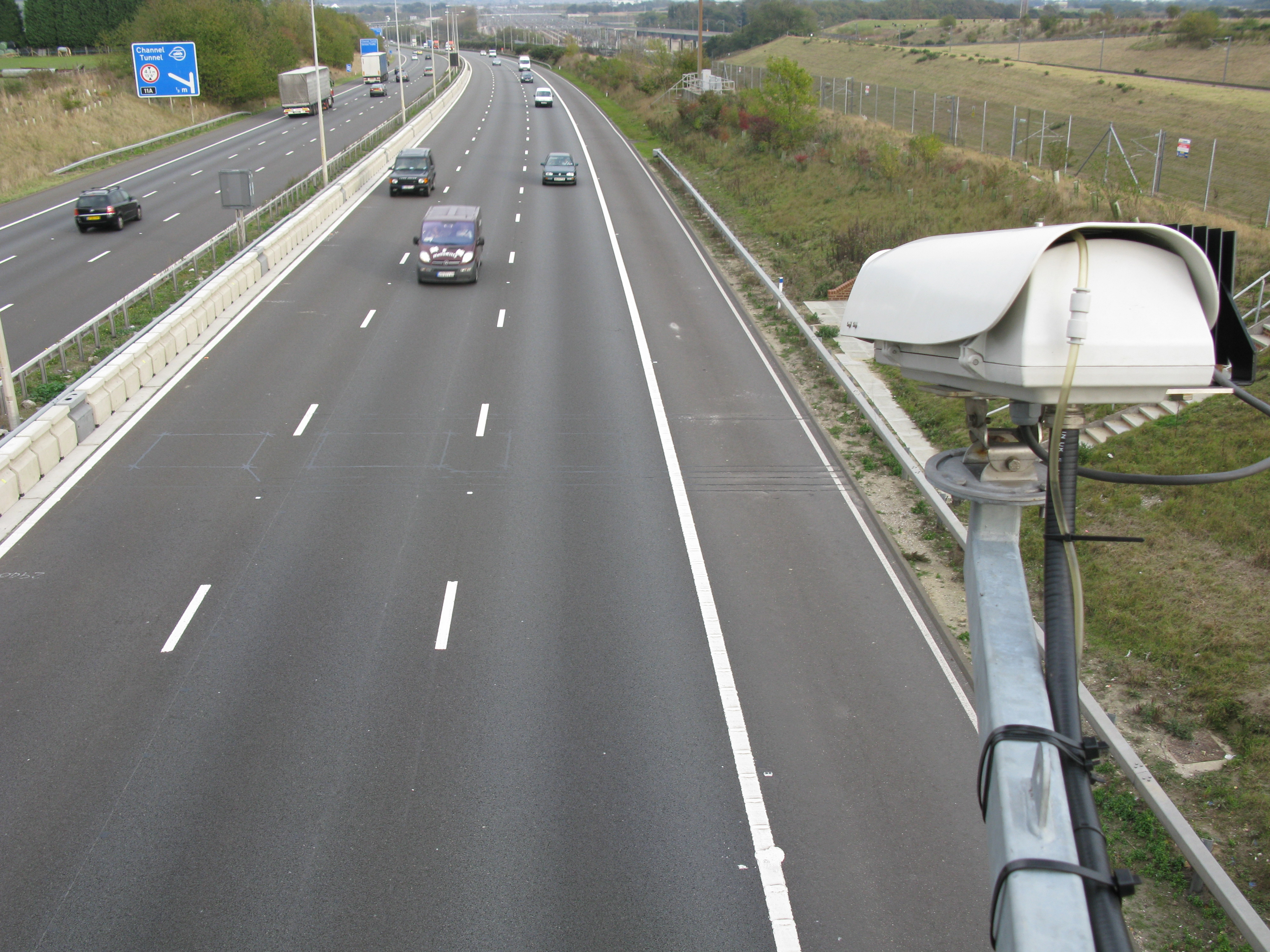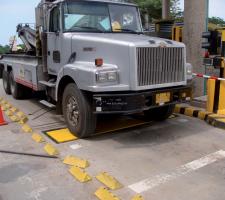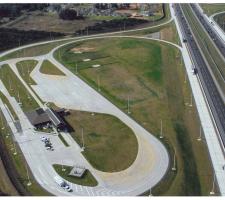
The weigh in motion market remains especially buoyant and technological development continues to reflect this.
Although there are major differences in operating philosophies, particularly between developed and developing countries, both the numbers of countries using Weigh In Motion (WIM) technology and the numbers of systems that they deploy are on the increase.Across the board, greater system integration is a common factor, with WIM being combined with other technologies to realise or extend applications. However, whereas in the developed world the recent emphasis has been on data gathering, infrastructure preservation and environmental impact (Mark Phillips of
Hardware advances
Processing power and memory increases coupled with advances in communications technology underpin the advances being made.According to Applied Traffic's Alan Cook, processing and memory increases have enabled his company to introduce complex learning algorithms which track changes within the road infrastructure and apply auto-compensation.
"Embedded internet technologies have also allowed us to include FTP server and NTP clients in the outstation, reducing the need for bespoke download and maintenance software as general-purpose programmes can be used," he continues. "We've also used wireless VPN technology to trial systems for customers on the other side of the world, providing a seamless, secure experience with no extra communications costs for either party."
New communications technology has provided a mechanism whereby customers with different aims, such as enforcement and gathering statistics, can combine resources. TDC's range of HI-TRAC traffic counting, classifying and WIM systems utilises GPRS and 3G packet-based communications, allowing vehicle traffic data to be transmitted and received across cellular telephone networks and the internet. GPRS is proving itself far superior to GSM communications for downloading of data, according to end-users.
WIM in combination
It is WIM's use in combination with other technologies which has been the biggest trend in recent years and the UK Vehicle and Operators Services Agency's (VOSA's) VIPER system, which was developed by the Weight and Safety Partnership/Project WASP, was something of a watershed.Alan Cook was the WIM technical adviser to the multi-agency partnership behind it: "The task was to develop a fully integrated WIM/ANPR system for real-time pre-selection of overweight vehicles.
"Until that time WIM integration with other real-time systems had proven too difficult. The systems would work at reasonably low vehicle densities and speeds but data pairing under motorway conditions was difficult. The WIM system had to be able to process the signals from in-road sensors and produce a time-stamped vehicle record. Different vehicles' lengths, axle configurations and speeds mean processing times are not uniform. Real-time clock drift in the pairing server and the WIM magnified the problem.
"The solution was to use GPS time to continuously synchronise the WIM system real-time clock at the roadside and the remote ANPR server. For the first time, we could accurately match WIM and ANPR data at high speed in dense traffic. The project was a resounding success and led to nationwide roll-out of the VOSA VIPER systems."
Applied Traffic, with VOSA and Civica (the ANPR partner), picked up the technology award for innovation at the
The next step according to Mark Phillips is to utilise existing in-road statistical WIM systems to achieve the same aims. VOSA and other enforcement authorities are working on this with
TDC has provided a simple interface which allows the technology developed under Project WASP to lend itself to mobile deployment. A similar system used in Florence, Italy features a programmable digital camera with Ethernet connectivity, TDC's HI TRAC EMU WIM counter-classifier and associated in-road sensors. The HI-TRAC EMU triggers the camera to take an image of a vehicle passing over the in-road sensors. A weight record is transmitted from the EMU to the camera and the data stored with the image. The camera resides on a private Ethernet network and transmits the image and data back to the customer's control centre server.
Traffic officers located downstream can see live images of possible overloaded vehicles on 3G-enabled laptops. The graphical display provides on-screen images of up to five vehicles at a time and a zoom facility to aid identification by number plate. A countdown timer associated with each vehicle shows when it is expected to pass the officers' location. Overweight vehicles can then be intercepted.
"The advantages of the system are its simplicity and cost-effective data acquisition," says Phillips. "TDC has just received three new orders from Italy for enforcement WIM systems. As a result of trials undertaken in France, a multi-sensor array consisting of four to eight piezo-electric sensors per traffic lane will be used to increase accuracy and repeatability."
"They provide enforcement information and support without the need to revert to fixed weigh stations. They also address the land price issue which can bedevil permanent facilities. That can be a significant obstacle; I can think of one site in California where a permanent installation would have cost over $20 million."
The VWS concept allies high-speed WIM to an increasing range of identification techniques, enabling both hard and soft enforcement regimes (on-road enforcement or the mailing of citations).
"In the US, bridge protection is a rising application with WIM being used ahead of structures to enforce and monitor weight restrictions," Hanson continues. "In many respects, that's more of a data collection approach where more information is needed on the country's vehicle population and it provides feedback to bridge designers."
Mettler Toledo's Bob Susor highlights the use of virtual WIM to prevent drivers of overloaded vehicles attempting to bypass routes where there are fixed weigh stations.
At this year's
As a solution to frequent closure and trucks bypassing the State of Florida's I-4 weigh station, the two had cooperated to develop a new, automated weigh station facility which integrates WIM, Vehicle Dimension In Motion (VDIM), licence plate recognition and a vehicle overview image.
The new facility undertakes compliance checks while vehicles pass by on a deceleration ramp at up to 50 mph. This significantly increases throughput as non-violators are immediately directed back to the interstate.
The entire system is modular, so components can be added or removed to accommodate various applications. This also allows components to be added and integrated to existing weigh stations without significant cost or impact on the facility.
Susor also notes the increasing use of WIM in place of static scales at seaports, which both increases throughput and reduces the costs of ownership.
Further integration in pursuit of yet more applications continues. Both Applied Traffic and TDC Systems have been involved in work relating to the Footprint project, which was conducted under the auspices of Europe's EUREKA initiative. As its name suggests, Footprint set out to relate the environmental footprint of a vehicle to the lifetime cost of maintaining the road infrastructure. Applied Traffic introduced the environmental monitoring systems trialled by the UK DfT to measure vehicle-specific noise levels coupled with real-time weather data.
"These embryonic systems demonstrated that it was possible to integrate multiple real-time events and this principal can be extended to a range of environmental and safety applications," says Alan Cook.
In a similar vein, TDC has developed an integrated solution for measuring and quantifying such impacts in a transparent manner. Equipment installed at the roadside is interfaced directly to the HI-TRAC WIM system and records information on pass-by noise, wind speed and direction, air/road temperature and ground vibration as well as indicative gaseous and particle emission levels. The vehicle data is tagged with the environmental and air quality data and sent in real time via GPRS/3G to a central database for analysis. The Transport Statistics Division of the UK DfT has recently purchased a number of these systems and clients including Transport Scotland and several UK local authorities are expected to follow suit.
Tolling applications
There remains quite a gap between developed and developing countries in terms of the effects of vehicle overloading on infrastructure, says Randy Hanson: "In developing countries, WIM allied to tolling is a very hot topic. In all of the projects IRD is currently involved with in China, for instance, WIM is installed in the running lanes. The emphasis there is less on enforcement and more on revenue generation - overloaded vehicles are simply charged more. China is one of the developing countries which need the government to take a line on this but it'll take some time - at least another decade. In India we're starting to see some progress, with slow-speed WIM being installed at toll facilities and severely overweight vehicles being pulled off the road."In past years there has been a clear distinction between the markets for High- and Low-Speed WIM (HSWIM and LSWIM). These markets are now merging and tolling is driving this, says
"Traditionally, HSWIM has provided statistical data and pre-screening of heavy trucks at normal road speeds prior to controlled overload enforcement on a more accurate weighing device. System accuracy varies greatly and is made worse by the inferior roads frequently found in developing countries. It can result in a single peak weight reading being taken which is totally dependent on vehicle bounce; the worse the road surface, the greater the bounce and consequent weighing error. The information produced is difficult if not impossible to use for prosecution purposes.
"LSWIM is a very controlled process and many countries have clear codes of practice for its use. Systems are approved and tested to an accuracy of 0.5 per cent, some eight times better than the best HSWIM products operating in ideal conditions. This is conducive to an efficient enforcement regime.
"Tolling allows a maximum of six to 10 seconds to weigh and process a vehicle, whereas LSWIM typically needs about 30 seconds. Manufacturers either improve and control the accuracy of HSWIM or improve the speed capability of LSWIM without sacrificing accuracy. Inevitably this will require compromise but it is essential that products, installation and testing all meet a common international standard.
"New medium-speed weighing products such as Central Weighing's Supaweigh 5000 and 5000c meet the requirements of OIML R134 for in-motion weighing and achieve outstanding and repeatable accuracy even at up to 20km/h. This makes them ideal for tolling applications. The products have been integrated with the ANPR and slow-speed classification systems required to automatically determine vehicle identification and class, both for tolling and weight enforcement.
"It is the developing countries which are making the largest investment in new toll roads and which have the greatest problems with overloaded trucks. There are proposed installations in some countries of many hundreds of toll plazas, each handling up to 7,000 vehicles per lane per day, and from trials in developing countries we have seen levels of truck overloading as high as 65 per cent. Such investments need to be protected by a sustained weight control programme."
Future developments
To support fixed installations Central Weighing has developed Freeweigh. This is an advanced, high-end, portable weighing system with a capacity of over 30,000kg/axle designed to withstand the climatic and operating conditions found in many developing countries and to provide the advanced weighing data collection and reporting facilities required in many developed markets. Freeweigh provides Ethernet communications and data transfer by memory stick to a remote PC. The system can use a variety of power sources and is fully approved to Class 4 EC standards.Full PC-based enforcement and fleet management software is available through Freeweigh for Windows to meet every application and the system is designed for multilingual operation - on-screen country selection means that the appropriate weight limits and vehicle classifications are into Freeweigh's operating programme.
At TDC, bridge overload protection is now a main driver of WIM system development. The company has recently completed contracts for the supply of systems for the Erskine and Humber bridges in the UK.
The Erskine Bridge installation includes a four-lane WIM system with ANPR cameras. All vehicle images and weight data are stored on a central server at the bridge office. For all vehicles detected by the WIM system as being overweight reports can be produced including image information as well as axle, gross and excess weights, vehicle type, speed, length and time of passage.
An abnormal vehicle report can be produced at the click of a button, including every vehicle over 50 tonnes that has used the bridge in the last six weeks. The operator can discern from an image if the special running license is correctly displayed. Continual offenders can be readily identified and the information provided to the relevant enforcement authority. Statistical WIM data is streamed to the national Scottish Road Database for analysis along with other data.
A successful year-long trial has also just been completed of the high-speed WIM system installed on the West Gate Bridge in Melbourne by TDC Systems Australia. The system was installed for
The West Gate Bridge, the third-longest in Australia, is a vital link between Melbourne's central business district and western suburbs, and carries four lanes of traffic in each direction. All are monitored by the HI-TRAC100+ giving accurate vehicle-by-vehicle traffic weight and classification information.
"This installation is unique in as far as the WIM sensors are located in the middle of the suspended section of the bridge in 50mm of asphalt above a steel plate," says Mark Phillips. "The HI-TRAC system is modified to work without the inductive loop and to tune out oscillation signals. The electronics are installed inside a cavity inside the bridge deck."
There is yet more to come. In the longer term, Randy Hanson says that he can see a collapse in interest in roadside infrastructure for data collection.
"Multi-use systems are going to become more and more popular as money gets tighter and tighter. Over the next decade, I can definitely see technology moving to support the use of common, centralised, Web-hosted data sets by multiple users." Asked about just where IRD is concentrating its R&D efforts, he becomes somewhat coy.
"There are two or three new things which may make a difference - opportunities to improve accuracy. One thing that will help is making sensor technology more robust and reliable, and one way to increase damage resistance is to get away from surface mounting."













